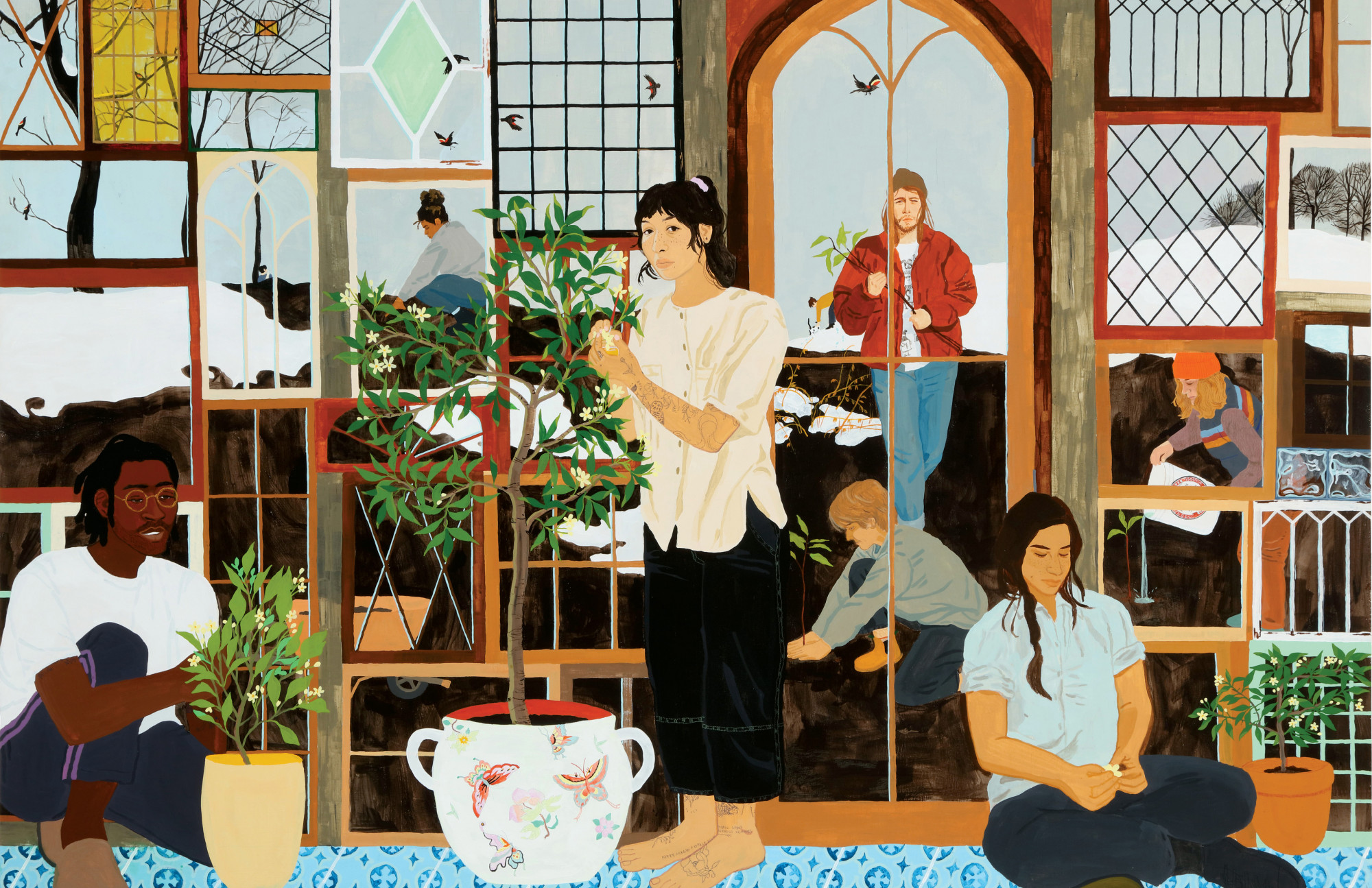
Composition is nothing more than the fruits of an unexpected meeting between separate worlds and the promise contained in the becoming commune of that meeting (tree planters in the snow), 2022, acrylic and colored pencil on wood panel. All artwork courtesy Dianna Settles and MARCH
The Entwining of Matter
Dianna Settles infuses her paintings with flora, earth, water, and breath
By Alyssa Ortega Coppelman
Born in California, moving often, and briefly living in a car with her mother when she was a child, artist Dianna Settles spent the majority of her childhood in Blue Ridge, Georgia, near her grandparents. Attending college first in Georgia, she graduated from the San Francisco Art Institute, and relocated to Atlanta, where she’s lived since. Parallels can easily be drawn between the patchwork of her early life, with its assemblage of locations and living situations, and her artwork, in which Settles unifies disparate moments and people into one painting. In much of her recent work, Settles portrays her life at Crack in the Sidewalk Farmlet—a sustainable homesteading community in Southeast Atlanta on what was once dairy farmland—where she’s lived with her partner for several years. While Settles paints from life, she creates community within her compositions just as she does in reality. She routinely invites friends and family who weren’t present at the same moment, have never met, or are no longer living into a singular frame. She knits together moments and actions that didn’t occur in the same location or at the same time. And sometimes, she will include a shout-out to another artist by incorporating a detail, like a tree or flower, from one of their works into her own.
Having worked as a kindergarten teacher, printmaker, tattoo artist, and co-owner of the collectively run Hi-Lo Press and Gallery, Settles is now able to paint full time. She keeps a rigorous schedule. Every part of her life ties into her art, and her art depicts her life: a conscious, thoughtful one that takes into account her impact on the molecules around her—living, breathing, eroding, and growing flora, fauna, earth, water. She exerts what might seem an unnecessary amount of effort to make readily available materials like gesso (which many painters prime their canvases with before beginning a painting, and every art store sells). Yet doing so deepens her practice and reinforces the connection to her lineage, as her maternal grandparents were also artists.
Settles’s influences are diverse. Politics, history, a meticulously constructed reading list, and art from all disciplines inform her work. Most crucially, a 2014 visit to Vietnam, where her father is from, significantly impacted her style. Artwork by Vietcong artists from the 1960s and 1970s made a huge impression on her. It was also the first time she’d been exposed to artwork full of people who looked like her but weren’t being fetishized or othered, which can often be seen in the West. Their stylized aesthetic impressed her to the point that she reevaluated her own realistic style and made an intentional shift in her work going forward. She acquired from that time a fresh approach to her palette, adopting a simplified method to portray the features of her subjects, and focused on making paintings about being Asian American.
The connections between Vietcong-era art and her own work are clear: her paintings largely portray herself, often with a group of people engaging harmoniously in labor, leisure, and training activities for the collective benefit of both those within their immediate sphere and the world beyond. Settles seems to delight in coming together with others around a beneficial purpose for greater humanity—and it has always been the point to bring everyone along, to obtain a better life for the greatest collective of humanity as a whole. But her work is not so much an aspiration or an urgent call to arms as it is an encouragement: Though we will need to fight for it, it is within our reach to live more humanely, ecologically, thoughtfully, kindly. Settles shows us how.
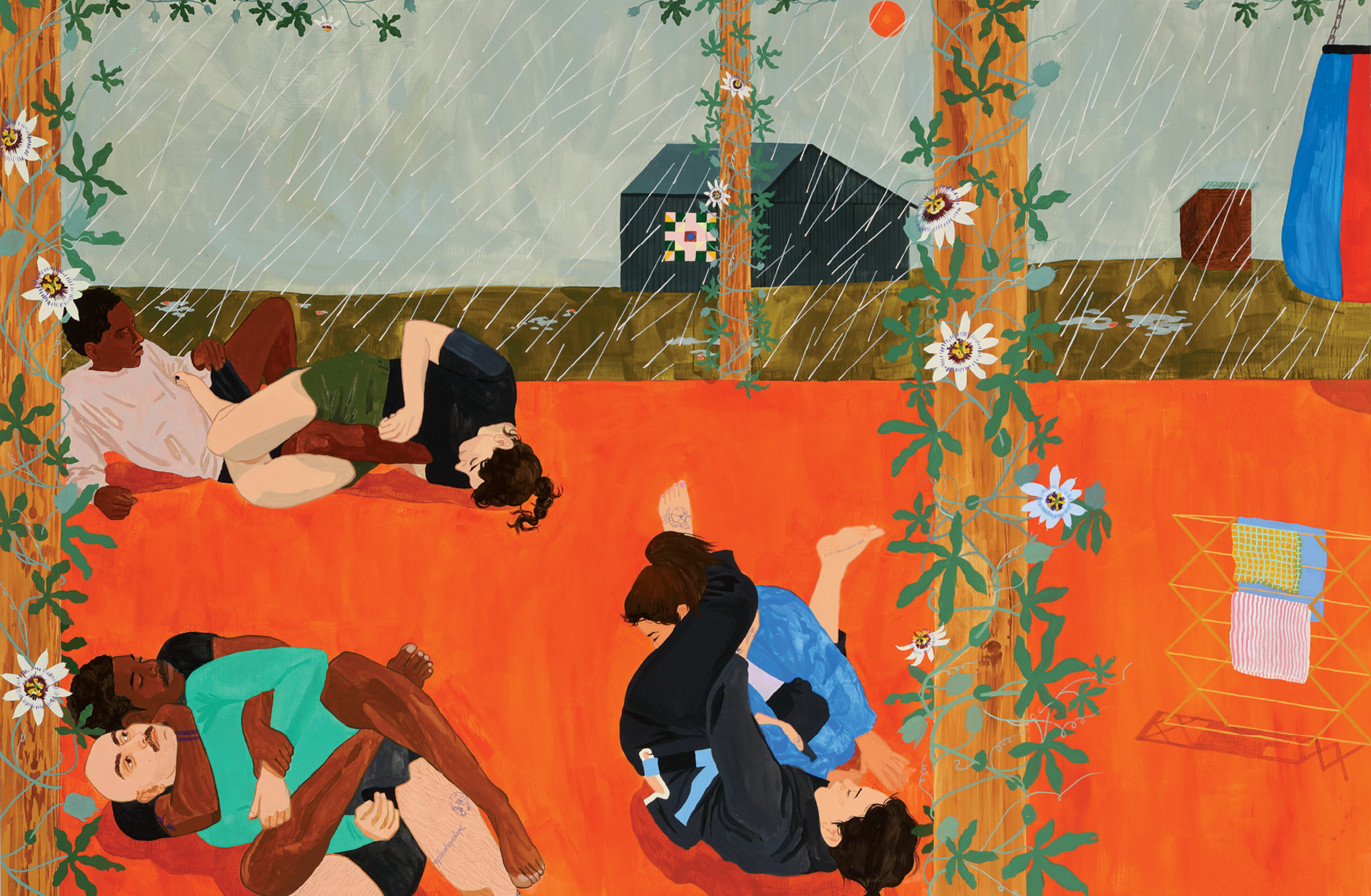
Good is the reckoning that uses no tallies and does no counting, 2023, acrylic and colored pencil on wood panel
Alyssa Ortega Coppelman: I’d love to talk about how everything in your life seems to inform your painting. Have you always felt that everything you did was a conscious decision? At what point did you feel it started contributing heavily to your artwork? When did you start developing the regimented schedule that you typically adhere to?
Dianna Settles: A lot of the things I invest the most time in are spurred on by similar desires—desires for autonomy, connection, proprioception, and a pointed quest or yearning to break down the deep sense of isolation and alienation so many of our interactions are imbued with.
When I list all the things I’m interested in—I do Brazilian jujitsu and I do farming and I put together art openings and poetry events and I’m interested in furniture building and basket weaving and natural dyes—so many of them are informed by wanting to be in and know my body and my surroundings in a deeper way. Once I understood that a lot of them shared an origin point, it became easier to understand the ways they relate to one another, and how all the things we choose to spend our time on shape all the other things we do.
It’s become more evident the longer I am alive that I have to figure out ways to balance these things. Because I am fortunate to be making a living right now off of making art—and having come from the upbringing I had, and my adulthood being punctuated or shaped by the feast-or-famine hegemony—it would be hard for me to not just be painting. Painting is the breadwinner right now. All other passions have to take a backseat. But I understand now that my paintings will not be as good if other aspects of my life are not being tended to and cared for. Farming has made a difference in my relationship to making paintings, especially failing.
Failing at farming, failing at painting, failing at all kinds of things. But failing at farming is serious and it’s brutal. When [COVID] lockdown started, I remember thinking I was going to paint so much. I felt so overstimulated and overwhelmed by that very particular type of isolation, even though we have many friends living on each side of us—across the street, a block away. I couldn’t make any paintings for the first several months of lockdown. My partner and I live on a farm that our friends across the street started about fifteen years ago. Going to the store and seeing people panic-shopping, and there’s no flour and there’s no pasta and the canned goods are really low, I think I had a particular trauma response to that, growing up with food scarcity, so it made sense to start learning how to grow things.
With farming, your effort is so clearly reflected in the yields you get—your effort plus a number of other invited and uninvited collaborators [such as] the climate and pests and diseases and all kinds of things that can affect crops. At first, I felt devastated over and over again when, for example, these beds we planted, tilled, and spent days prepping [are] now completely shaded because the leaves that were just budding when we started have filled in, and now all these plants that need direct sunlight are not getting it. So, they’re getting overtaken by weeds. There’s nothing we can do when that happens but add it to our arsenal of knowledge for how we’ll prepare in subsequent seasons.
I feel lucky to have had a transference to the studio of that same learn-and-keep-going [method], because in the studio, there are plenty of times where I’ve painted one person’s face twenty times, staring at it and wondering, does that look [like] their nose? I can’t tell, and I am frustrated. Instead, I learned ways to be okay with it—that thing I just tried didn’t work, and that’s it. Let’s try again.
Do you paint from memory, or are you using reference photos?
The process I have for putting together paintings and figuring out the compositions is a mixed-up, long process because so many of the paintings I’m doing are either ephemeral or potential moments. A lot of the time, I’ll want to make a painting of making tinctures with a bunch of friends. It would be bizarre if, while we’re processing a bunch of herbs, I sit there taking pictures and documenting everything. Instead of doing that, I write “tincture making” and think about all of the different steps that happen. Someone is chopping roots, someone’s sorting, and someone is measuring.
Sometimes, if I made tinctures with my four friends, it’s a painting of the five of us doing this. But more often than not, I’ll integrate people who were not there, who I know have done this or would be interested in doing this, but not necessarily something that we’ve ever done together. Or I’ll think, I want these twelve people to be in this painting. Lately it’s been a combination of friends of mine that are living and friends that are not living any longer. I’ll think about the shapes people’s bodies make while they’re working. That’s where the composition starts becoming more material.
If I want someone to be sitting with one foot tucked under their butt on a high stool, at a counter cutting something, I’ll think of who I want it to be. I want Sophie to be doing that. Typically, I’ll set up my phone and record myself in the pose I want, or ask my partner to. I’ll send that to the person I want to paint in that pose. I’ll tell them I need a picture of them in the same pose, and they’ll send me something back. Sometimes they’ve got a good understanding of what I’m asking for. And as many times, not at all. I’ll make little sketches from those and Tetris them together, which is especially fun because in the paintings that are more of a projection or potentiality, some of what you see is taking place in spaces that don’t exist or are wild amalgamations of many different spaces I’ve been in.
Is Old wisdoms, lively passions, nothing was missing. Not even heaven’s help, 2023, the one with the sheep, pieced together in that same way?
100%. The person working at the loom is a friend of mine who is a weaver. When I was thinking about making a sheep-shearing, wool-to-thread-to-tapestry painting, I wanted Claire to be in it because Claire’s a weaver.
But for the two people who are shearing the sheep, I needed a picture of them bent over, [and I told them to] hold a pillow if they wanted, so they did. They didn’t know what they were going to be doing in this painting. This one’s a good example, because with interiors, I try and incorporate pieces of other spaces that feel connected to this moment or desire or orientation. Another good friend who passed away this last year was a weaver. This painting is inspired by her. I was thinking a lot about her while I was making this because I had just found out that she had gotten sick when this painting was in its beginnings. She’s not physically depicted in this painting, but the weaving on the wall next to the little pansy is one of her weavings.
Thinking about current events and the political, philosophical, and historical influences that inform your work, have you felt that your work is moving in a different direction, or that politics are informing what you’re doing now more than at the beginning of your practice? Or is it seeping in, in ways you can put your finger on?
I think that the impulses behind what I make paintings about have remained consistent. Reading is another part of my painting practice. Everything I read helps me insert the work I make into the very long struggle to attain freedom for everyone, and to have a life worth living, a life worth fighting for.
I grew up in a town of about 1,200 that was about 98% white. My dad is Vietnamese. My sister and I were harassed pretty intensely by people who seemed very shaped by racism. And we grew up extremely poor. I had a lot of insecurity when I first moved to Atlanta, being a little country bumpkin and having friends who I felt were cultured and well-read. I grew up in a house without books. I felt so scared to participate in conversations. I would read things, and if it made sense to me too easily, I just thought I must be so stupid and that I just don’t understand, because there’s no way that philosophy [for example] can make sense to me with my Fannin County education.
Whereas a lot of my friends who grew up with more privilege acquired a class consciousness through reading, I gained a very material understanding of class being a young kid going to the welfare office with my mom and not being old enough to understand the cruel maze of bureaucracy and the ways access is controlled. But I understood that we were hungry, and I understood that there were people who said they were going to help or were trying to help us, but that it never felt sufficient. I have had a number of revelations like that throughout my life.
Right now, something that is interesting is seeing how many people understand what’s happening in Palestine, not through being Palestinian or having close friends that are Palestinian, but by being someone or the child of someone who’s experienced colonialism. One way of talking about it is in terms of inherited trauma, generational trauma. I understand the deeply devastating horrors that my father and his family members experienced—his family members that were killed during what in Vietnam is called the American War. The way that turned into anger and not being able to communicate these things and also having it swirled into the model-minority myth and getting sponsored by an American family to finally come to the States and choosing which parts of yourself to erase in order to assume the identity of a person worthy of an American citizenship is a pretty wild thing.
Or maybe a more positive way of interpreting intergenerational trauma with a bit more autonomy or force is to imagine it as generational desire—and generations and generations of my family have experienced the existence of colonial force and military violence. Because of this, I have a deep desire to have freedom of movement and access to space and a way to put down roots and feel a deep connection to something. There’s definitely something terrifying about the white phosphorus the Israeli government is dropping on Palestinian and Lebanese people. And I can’t imagine not speaking about it. There are so many people who feel the same way—that we are seeing the things that our parents, our grandparents, our great-grandparents have told us to look out for. And some of us are looking out and are sounding the alarm. And some of us are trying really hard to say that that’s not what we’re seeing.
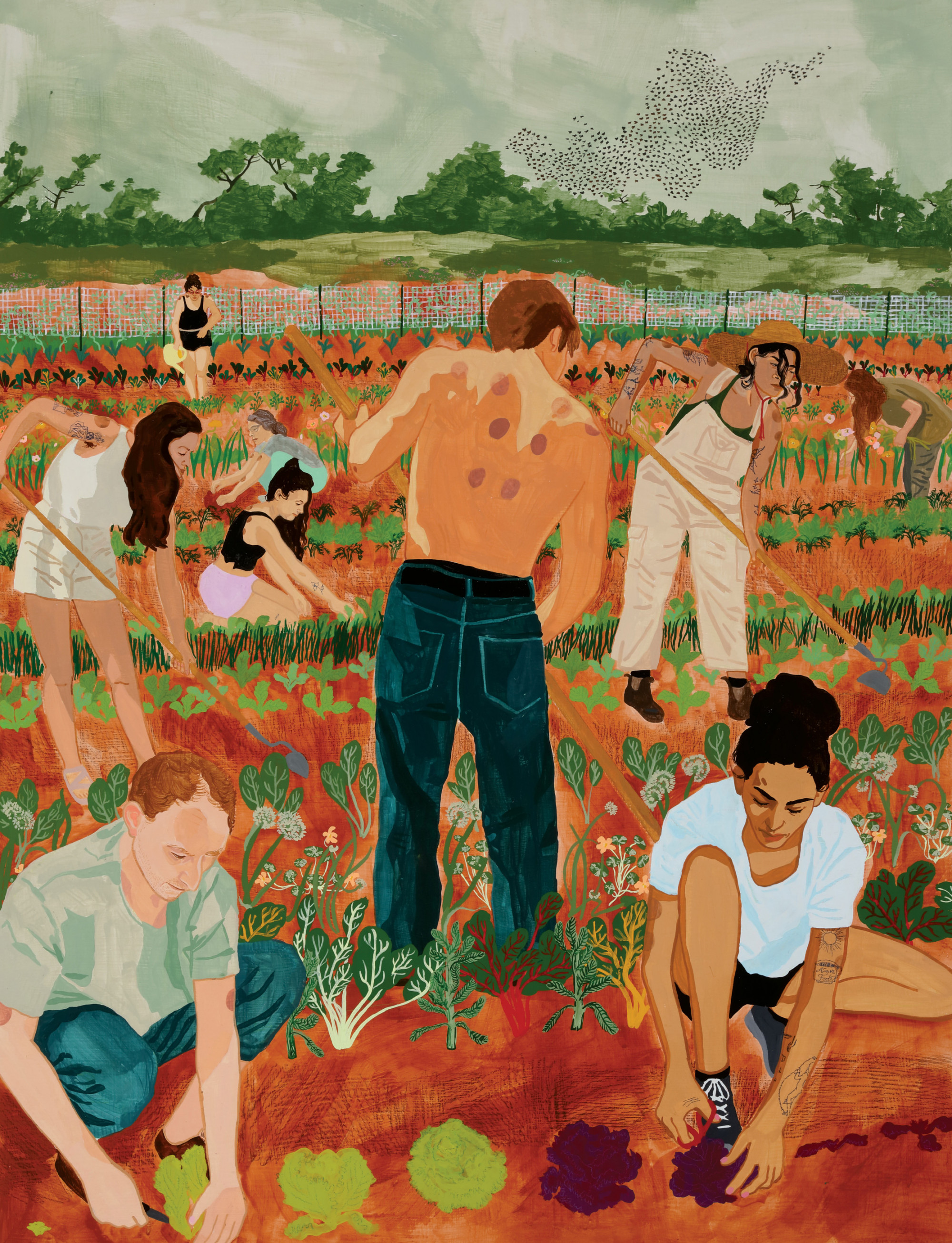
How do we follow after you? Cupping circles, culling rows, 2022, acrylic and colored pencil on wood panel
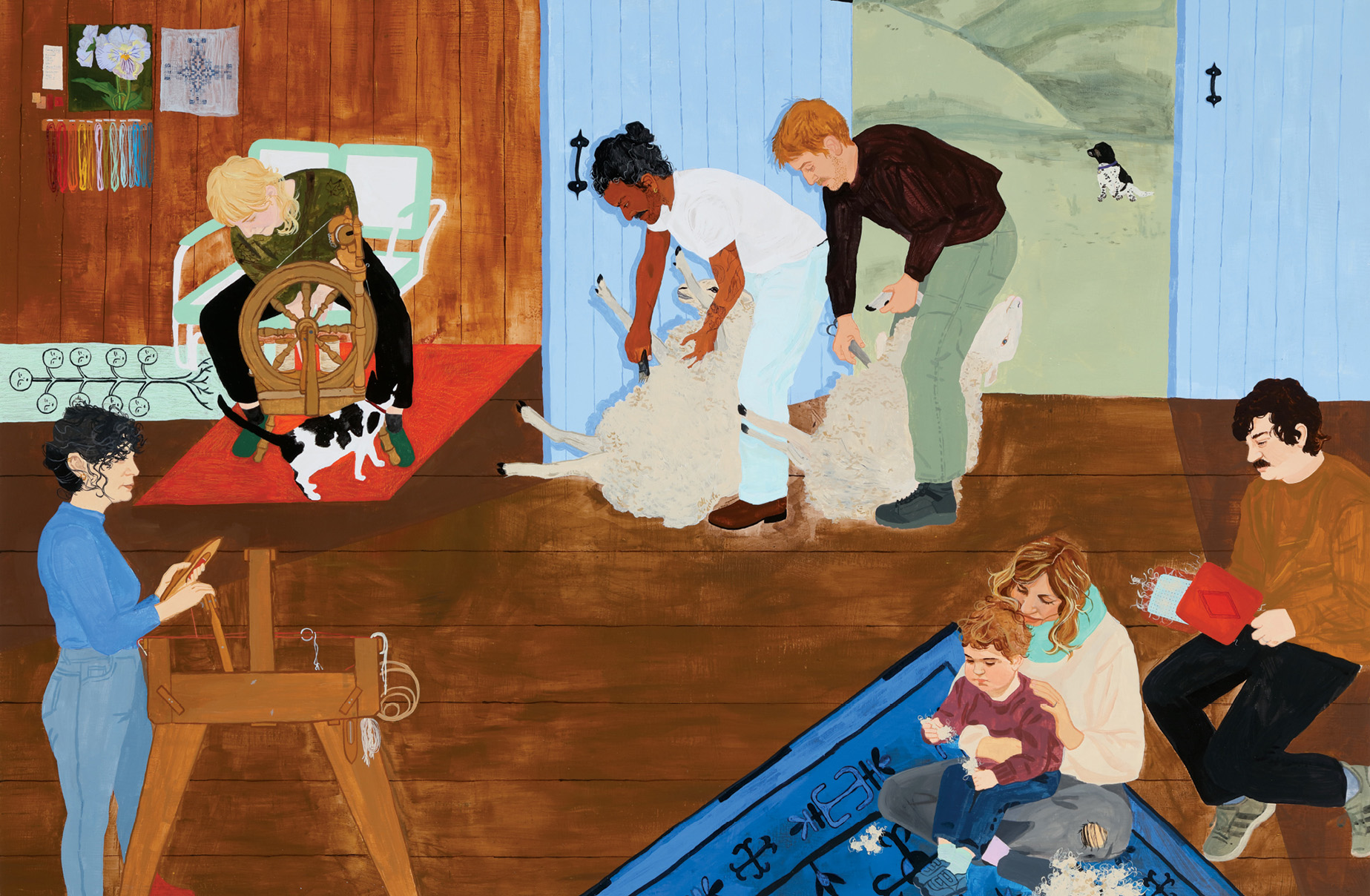
Old wisdoms, lively passions, nothing was missing. Not even heaven’s help., 2023, acrylic and colored pencil on wood panel
What have been the biggest obstacles to living a life worth living, worth fighting for?
The biggest obstacles? Speculation, capitalism. Here’s a concrete example. I have a project that I’ve run since 2016 called Hi-Lo Press. We’ve had art openings and poetry readings and screenings and workshops and critiques and dance parties and drag drawing classes and painting clubs. For the first four and a half years, I felt I couldn’t do any of my own art. I just had to figure out how to make enough money to pay rent on this building. Sometimes that meant I’d design t-shirts for my friends’ bands or do tattoos or babysit or sell some shit. I’d make it work because it’s important that people have access to a space they don’t have to pay money to participate in and where they can talk and meet people and share ideas and try new things.
Then it became unsustainable; in four and a half years I’d spent $50,000 paying rent on a place. And, I’m a person who doesn’t have family wealth and can’t ask for help when the rent’s overdue by two weeks. My partner and I and other friends started having rent parties, which there’s a long history of. Once a month we had two friends deejay and charged $3 to come dance. We’d move everything out of the way so people could dance. We’d build a little fire pit and sell cheap beers. In one night we would make one to two months of rent. [It allowed us to] do all the things that we wanted to do with so much less pressure.
Then COVID happened and we couldn’t do them anymore. So we organized a rent strike, drafted a letter, and the neighbors—all five tenants in the strip that the original Hi-Lo space was on—submitted this letter, and it felt incredible when all the tenants were a unified force. But two of the tenants started paying, which put a lot more pressure on the three of us who were still striking. Eventually the new owners of the building decided they weren’t going to renew the lease after I’d been there for five years. So then, well, what if we don’t need a physical space to do events? And someone who’d heard about what we were doing let us use a house they had bought in the neighborhood. We called our time without a space Hi-Lo in Exile. We did shows in this house, we did shows in a tunnel, we did shows on the farm. That felt incredible because there are moments where, through upheavals and various forms of disaster, openings are made. And then you see how malleable things are.
And you learn that you don’t need a pristine white cube to have a gallery.
Right. I don’t actually need that. I don’t even need walls. What if instead we find a place that feels good or makes sense with the artists we’re trying to work with, and we get to have this experience that’s much more alive in terms of how their work gets to exist for a number of hours or days or [however long]?
There are a number of endeavors around this city where people have figured out how to make things happen. One group of friends finds abandoned buildings and scopes them out. If there aren’t a lot of houses in the area that have security patrols, they’ll spend a week cleaning up the space to put on parties and raves, and all the money they make from the raves goes to the Solidarity Fund, to getting people out of jail who are facing political repression, which is a big thing right now in Atlanta. And which is very tied to what is happening in Palestine, because Atlanta police have an exchange program with the Israeli Defense Force (IDF) which has been a thirty-year project.
The Atlanta Police Department wants to build Cop City here, and the IDF has Little Gaza in Israel. These police forces are sharing ideas. This is why we have to fight. And it’s important to find joyous ways of doing it because there are lots of slogging ways of doing it that are equally important. But you have to find the balance. It can’t only be this punishing dedication. You have to find joy and liveliness in it too because that’s the thing that continues to propel us towards finding those openings and making them big enough for as many people to come through as possible.
What I’m hearing is that you have always had to be this way, where the obstructions between you, your family, and your friends and living a decent life have led you to get creative about how to attain enough, and realizing that deconstructing the things you’re supposed to have—for example, the white-cube gallery space—and completely throwing that model away and coming up with a new way of doing things that is even more enjoyable than the original ideal that we’ve all been presented with.
Definitely. Ever since I was a little kid. We live in an extremely consumer-driven world, and even being little and seeing commercials for things other kids had, I knew we didn’t have money for that. So I’d wonder, can I make that? It was a hard way of learning interesting things, but I’m thankful for it too.
How about reality vs. fiction in the epically titled And when the time for the breaking of the law is here, be sure it is to take place in the matrix of our everyday thoughts and fantasies, our wonderment at how we got from there to here. (The black and green snake fights the blue one), your painting about Stop Cop City?
That day I didn’t take pictures. But this is how it felt. It’s maybe a romanticized collapsing of disparate hours. That day at the music festival, there was a procession and the Cop City construction site was sabotaged. That’s the black smoke cloud. And it did feel like there was this wild, green-and-black snake. In the title, that part in parentheses is what I added and the quote [in the first part of the title] is from John Ashbery.
When I looked at the type of Vietnamese artwork that influenced your palette and subject matter, some of their titles are quite long and descriptive, not exactly like, but similar to yours. Did the titles of that artwork affect how you title your artwork, or is it a coincidence? For example, and they’re not quite the same, but Planting trees and caring for forests is the responsibility of everybody. Yours would then keep going.
Mine would be another paragraph. Part of the thrust behind the way I title my paintings is what I was saying about my reading practice and establishing my place in this timeline of struggle. I’ll take from something I’m reading or have read recently. Sometimes, I dog-ear my pages, highlight them, or make little notes. Or if I’m working on, for example, three paintings in the studio, and something has a similar emotional resonance, I’ll put them together. Sometimes they’re pieces of two texts I’m reading or two sections of one text or a quote and a response to it or a quote and a slightly poetic description of something taking place in the painting. But [the way I title images] feels like another way of chaining those two parts of the practice together. And a similar way of taking what I learned from farming or from jujitsu and making them work together.
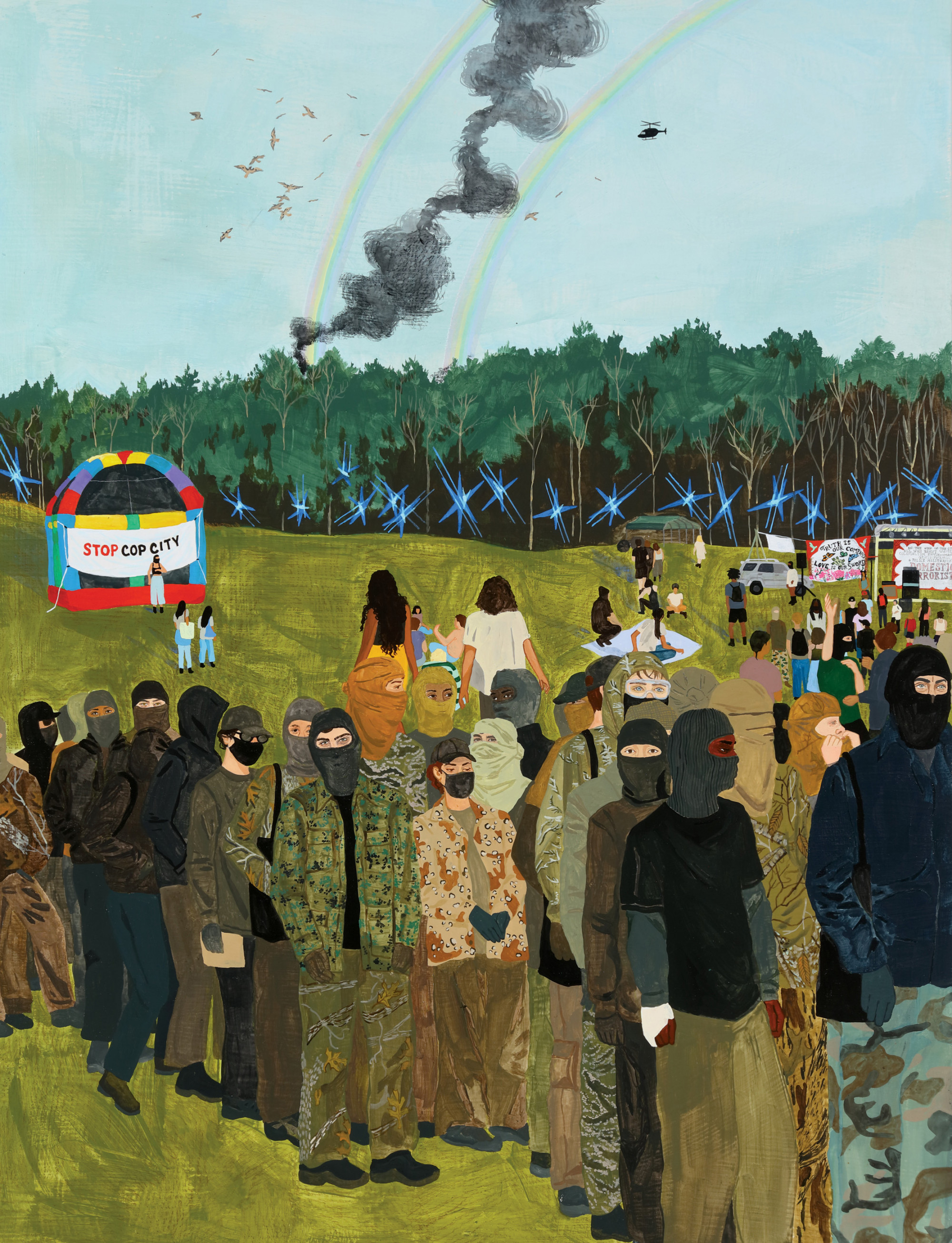
And when the time for the breaking of the law is here, be sure it is to take place in the matrix of our everyday thoughts and fantasies, our wonderment at how we got from there to here. (The black and green snake fights the blue one), 2023, acrylic and colored pencil on wood panel
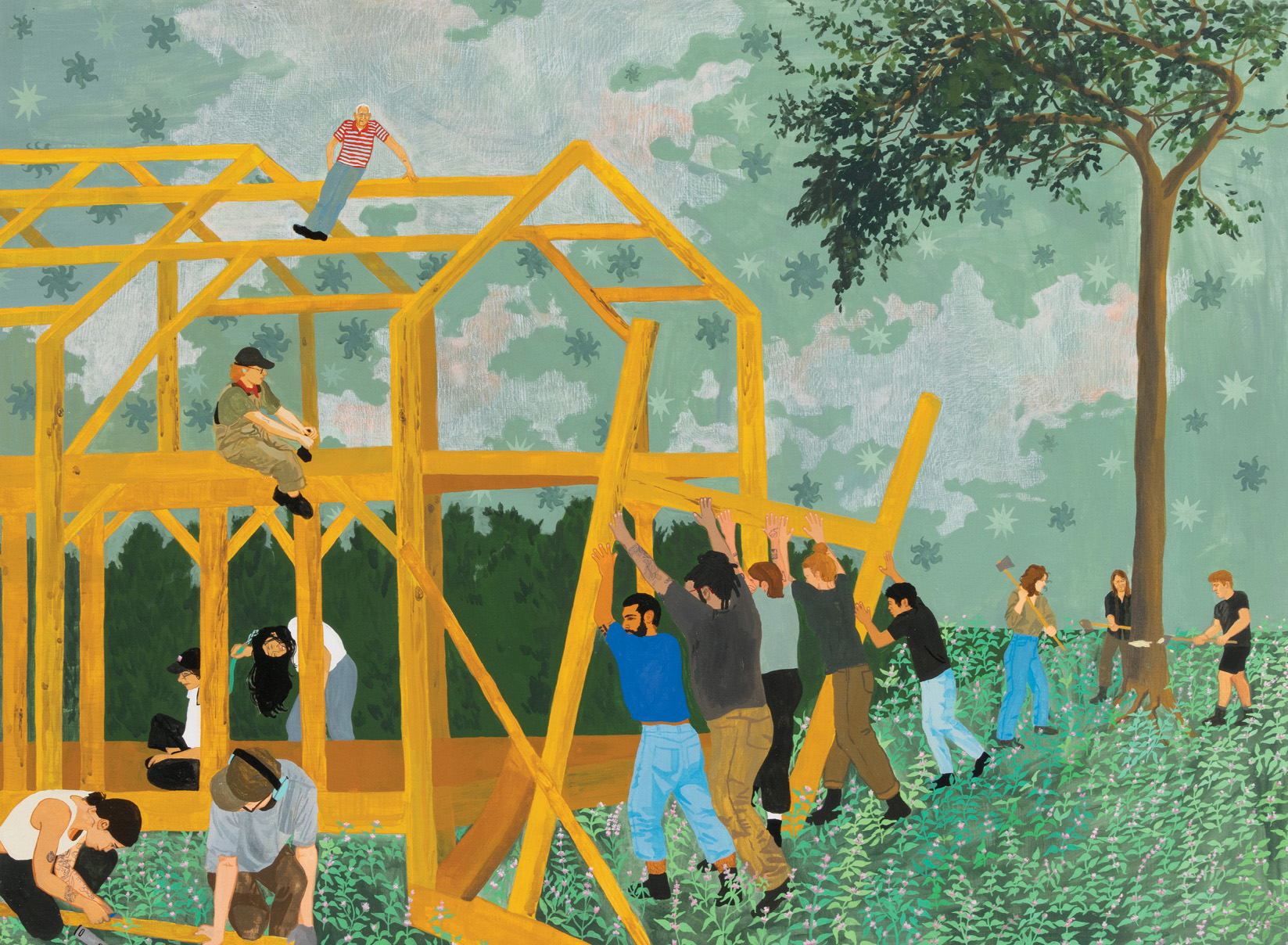
Constructing a world piecemeal with Common Areas at the Heart, with Zen Views, with Windows Overlooking Life, with Secret Places, 2023, acrylic and colored pencil on wood panel
I wanted to ask you about your materials-making, for example, gesso. You’ve said it helps with your practice, getting to know the materials intimately. In what way does this contribute to your practice?
In the same way as when I was a little kid, trying to figure out if I could make a toy instead of buying it. The idea of making my own panels came from necessity and curiosity because buying them at art stores is expensive. A lot of the time, they’re poorly made, and that felt infuriating. If I’m going to paint on a shitty thing, can’t I just make the shitty thing for less money?
A few years ago I thought, well, I can spend $100 on four panels at an art store, but what would it look like to make them myself? I have a truck—let’s go to this lumber store, and I’ll get four-by-eight sheets, which means I can have two big panels or eight medium size or a bunch of little ones and some medium ones and a big one. That felt like a meaningful or worthwhile and empowering thing to do. It’s similar to knowing how food you’ve grown came into being. I’ve stopped making my own panels, but I will pay friends to do it because they’re much more skilled woodworkers [than I am].
With the gesso, both of my grandparents were painters and when they died, I went through their studio and found all kinds of strange things, including a container of rabbit skin glue. I thought it was weird that they would have that, so I researched what you’d use it for and learned that, [along with powdered marble] it’s one of the components of traditional gesso. I love making my gesso because it’s not made out of plastic. It’s not a big, expensive tub of shitty material that I have to go and buy and feel infuriated and disempowered about. I would rather just make it.
Where do you get rabbits—do you make the rabbit skin glue? Or the powdered marble?
There are a couple niche stores for people who make their own paints and other materials. It’s not a super rare thing. I’m sure there are other uses because the hide glue is basically just a strong glue. There’s a farmer at the farmer’s market who used to sell rabbits. I thought I would ask them if I can get the skins, because I would love to make my own rabbit skin glue. And I hope my life will go in such a way that I can dedicate more time to knowing as many parts of the process and materials that I use as possible.
I’ve started collecting minerals, and the last few years I’ve grown indigo and different plants for dyes to make pigments with. But then I wonder, do I start growing flax to weave linen, stretch that over stretcher bars to make my own canvases? Do I start milling lumber myself, because I would love not to rely on plywood that’s filled with weird glues and chemicals?
And, your money goes straight back into your community that way.
It’s intricate. But instead of ordering from the Internet and two days later it arrives and then I paint it onto a board, it’s nice to actually know what I’d do if the Internet stops being a thing—which I would love.
Are there other materials you’ve looked into cultivating for use in your practice?
My Christmas gift was some charred deer bones I can use for making black, which I’m excited about. I’ve taken a couple online courses on making natural pigments: the madder plant makes a beautiful, extremely vibrant red. You use the root from that plant, but you shouldn’t harvest the roots until the plant has been established for five years. You can’t have stores of red pigment within two months.
In the painting of the house-raising, Constructing a world piecemeal with Common Areas at the Heart, with Zen Views, with Windows Overlooking Life, with Secret Places, 2023, who’s the guy sitting on top of the house in the red-striped shirt?
That’s my grandpa. That’s the first dead person I painted. All the people in this are people who I’ve done building workshops with, or they’re carpenters or construction workers, or are handy in some way and have expressed interest in making things they don’t regularly. I think that people who we love who have died stay alive in so many different ways, many material ways, where we’re breathing the air they’ve breathed and sticking our feet in the dirt they’ve stepped in.
Did building this actually happen?
Not at this exact scale. A friend of mine who passed had started this experimental school inspired by Black Mountain College called the Cabbage School. I took a class that two friends led called destructive writing. And I took a two-week class about shack building.
Have you ever heard of this book called A Pattern Language? It’s by Christopher Alexander and a number of other people. It’s about imagining building houses and neighborhoods and towns and organizing cities. In each house, there are things that are worth considering. Places for hiding, play spaces for children, communal courtyards and things like that. The shack-building class was cool because in the first several days we walked around a property paying attention to what direction the sun rises in and where it is in the middle of the afternoon. [We thought,] do we want to build something that’s shadowed? What is the purpose of the shack we’re going to build? Then we made little models.
We have to do that a lot when we’re growing things, too. But [I realized], I’d never thought about these things. I hadn’t [considered] space shadowing or intention. It hadn’t felt important to think about where the sun is going to hit in the morning versus in the evening. [Or] if I want to be cooler in the afternoon or warmer in the afternoon. It’s not a conversation that I’d had with my grandfather. I wish it had been. [This painting is a] way of having that conversation with him and bringing all of these threads together.
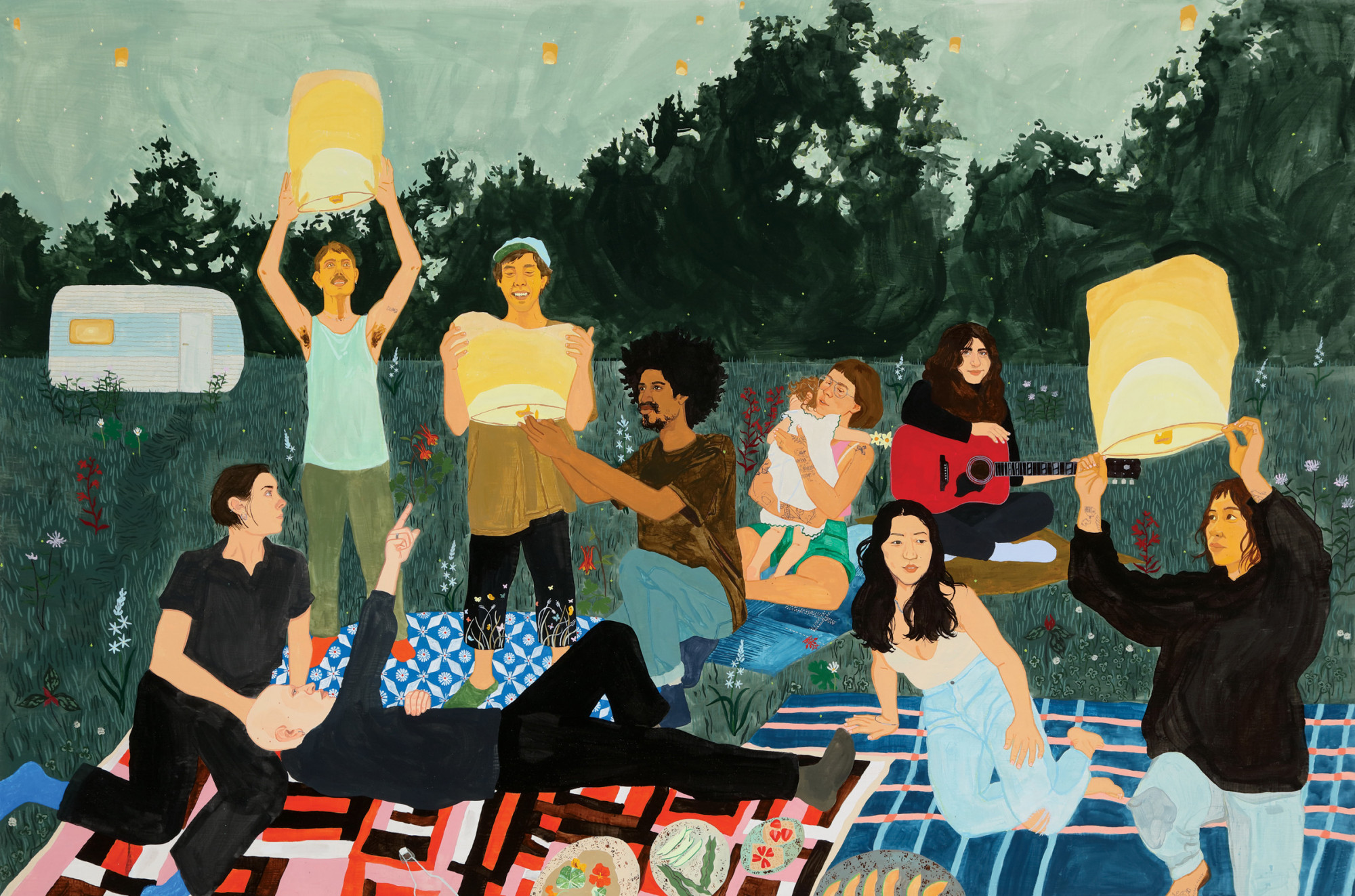
How the world this summer was full of flowers. The fireflies are waiting., 2023, acrylic and colored pencil on wood panel
Dianna Settles is a Vietnamese American artist in Atlanta, Georgia, who received her BFA from the San Francisco Art Institute in 2014. Her current work explores moments of joyful stillness amidst the cascading series of crises called modern life, accomplished through her synthesis of traditional Vietnamese and classical European painting styles. She was a finalist for the 2019 Forward Arts Foundation Edge Award and was recently accepted into the Atlanta Contemporary Studio Artist Program. Recent solo exhibitions include A Thousand Paths Bloom at Galerie Marguo, Paris, and A Life Worth Living Would Be A Life Worth Living at MARCH, New York City.



